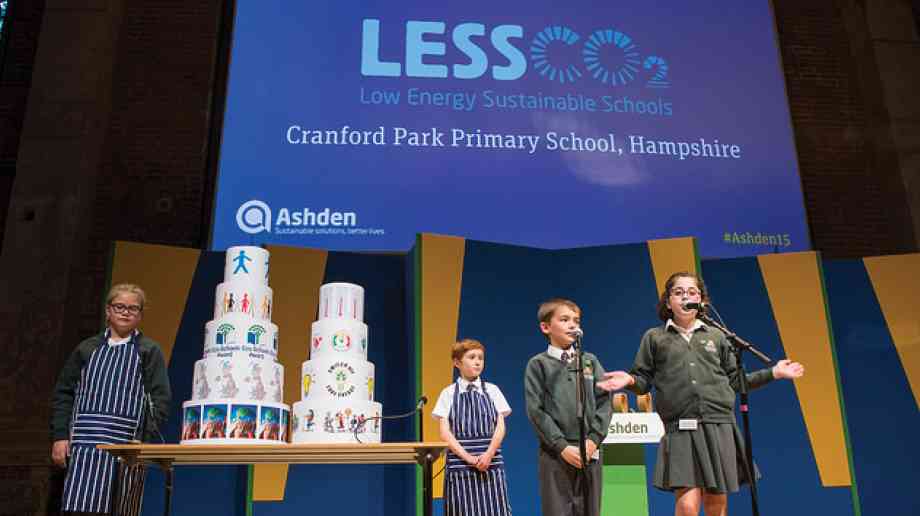
Teaching young decision makers about energy
Teaching pupils and staff about energy saving measures can reduce energy bills, add excitement to the curriculum, and teach young people good habits for a lifetime, writes Alex Green, school programme manager at sustainable energy charity, Ashden.
Running the Ashden LESS CO2 programme and working with schools across the country to help them to reduce their energy use, I meet lots of teachers, school business managers and site managers. One debate never fails to come up in our workshop discussions: should lighting and equipment within schools be automatically controlled through movement and light sensors, or should the users of these building be responsible for turning things off when they leave a room?
Our schools are teaching future decision makers – these youngsters will become the consumers, managers and business leaders of the future. They will also be future home owners or tenants responsible for energy bills. By making energy saving part of their everyday actions at this early age, we will be creating a more sustainable economic future.
When light and movement sensors are used with effective controls and override systems, students and staff can learn to control their own environment effectively. My own children are growing up as part of the smart phone generation – we need to ensure that they know that they do still have control over and responsibility for their surroundings.
Over complication
I am always impressed by the wonderful new-build schools that I visit as part of our LESS CO2 programme. These amazing spaces will undoubtedly be wonderful places for our children to learn. However, I also never fail to be amazed by the extraordinarily complicated lighting systems in classrooms with an array of fancy buttons and sensor-controlled systems.
I’ve seen movement sensors in unused corners, light sensors in all manner of locations, and don’t get me started on the location of the heating thermostats! Some rooms have no controls at all, whereas others do but the combination of double clicks and holding down of buttons leaves the school staff baffled. The result is that lights are left on in the hope that the magic of the automatic system will turn them off at some point.
During the judging visits for the 2015 Ashden Sustainable School Awards I met a little boy called Tommy from Marton Primary School in Lincolnshire. Tommy puts it very simply, he says: “Anyone can do it – it’s just a flick of a switch.”
If schools can grow a generation of children that turn their lights and equipment off when it is not in use, we have a chance of making changes within the tens of thousands of households in the UK. There are 8.3 million students currently in education across over 24,000 schools – this is too good an opportunity to miss.
Stephen Green, environmental coordinator at Ringmer Community College, and one of the mentors for the Ashden LESS CO2 programme says that “most of the staff at our college are degree educated professionals – they are more than capable of turning their computers off at the end of the day. We just need to help them to remember to do this by making sure that staff and students know that they have responsibility for their school environment. It’s about teaching them good habits which they can take into their own homes.”
When children and staff in schools understand that ‘every little counts’ when it comes to energy saving, and that all of their individual and small actions add up, this is when we can create a more sustainable community.
Combining the two
In reality perhaps this is not a simple debate, and there is no one solution. A combination of both switches and sensors will mean that we can optimise the technology where necessary. Either way, people need to know what’s there and how to use it. Knowledge is power – even when it comes to the basics of how the fancy light switch works. We need to encourage students and staff to take actions, and whenever possible make sure that they are empowered to take control, but also have technology as a back up to make it easier for them and for when the odd light is left on inadvertently.
So, I agree with Tommy, it really is just as easy as a flick of a switch – the power is just at the tip of our fingers.
Energy gobblers
It’s estimated that schools can contribute to over 70 per cent of carbon emissions from a council’s estate and no wonder as, left unchecked, schools gobble up energy. Simple measures such as managing room temperatures, the length of time heating is used for and other simple changes in energy culture could save £10,000-£15,000 on an annual energy bill of £100,000. This is before renewable energy sources are even considered.
In an age of ever tighter budgets, it goes without saying that those kind of savings could really be put to good use by schools and colleges.
Here are a few top tips for reducing carbon emissions in schools. Use colour coded stickers on light switches to indicate which can be turned off (green) and which need to stay on (red). Make sure staff know how to turn off whiteboards, monitors, TV screens.
Don’t block out the natural light by displaying children’s artwork on the windows.
Schools should get students involved – let them help decide what could be improved. This is a great learning experience for them which they can take into their future education and careers. They are also great at encouraging/nagging staff to switch off their lighting and equipment.
Schools should start measuring and monitoring what you are currently using in terms of energy. Get as much energy data as you can at the beginning of the process and learn how to calculate savings and payback times. This makes it easier to demonstrate the impact your work will have, and to support any funding requests you make.
Create short, medium and long-term actions to ensure that you are looking at quick and easy wins, as well as being ambitious with your bigger plans.
Plan your time
Don’t underestimate how much time you will need to do this – speaking to other members of staff, reviewing energy data and contacting energy suppliers all takes time. It’s worth investing time in speaking to staff in all departments in your school. Plan in this time.
Involve teaching members of staff early on. It’s good to have support from all corners. Help staff understand the cost of energy use at school by putting it into comparative figures they can relate to. For example, the cost of support staff hours in relation to the cost of leaving computers on overnight.
Link the building management staff with the teaching staff to ensure that they are working together to save energy in the school.
Team energy
Many of the schools that we work with through the LESS CO2 programme have gone on to create their own energy teams which are a great way of getting pupils to promote sustainability to their peers. There are several direct benefits to involving pupils in this way: they become enthusiastic about energy consumption and learn about a complex subject more easily; they are motivated to reduce their energy use at home as well as school, and inspired to come up with solutions; and involving them in participation through real responsibilities improves self‑esteem, which impacts across all learning.
The less co2 programme
Ashden established the LESS CO2 programme in 2010 in response to requests from schools for practical, hands-on support to help them make the changes they need to reduce their energy bills and to help build a low-carbon future.
As one participating teacher put it recently: “LESS CO2 has helped the children take up more responsibility in the school, and helped them to make others aware of the impact that they are having on the environment.”
Each year-long scheme includes four workshops covering various aspects of energy saving, from recording meter readings to monitoring energy use, behaviour change for staff and students, and incorporating sustainability into the curriculum. As well as the workshops, participants also receive mentoring from Ashden Award-winning schools and advice on steps to reduce energy use.
To date, around 100,000 pupils in more than 160 schools across the country have benefited.
Further information
www.ashden.org/less-co2
Latest News
30/10/2025 - 01:28
In the wake of the Raac crisis, the DfE spent £5 million on research into the condition of school buildings, which is due to conclude in spring 2026.
30/10/2025 - 01:09
Malmesbury Primary School in Wiltshire has submitted plans for a major expansion, funded by entrepreneur James Dyson.
30/10/2025 - 00:55
Monday's Every Pair Tells a Story campaign to protest to highlight the national crisis in SEND provision.
29/10/2025 - 09:19
Estimated data from the Department for Education reveals that 470,000 pupils under 16s use local authority funded transport to get to school.
28/10/2025 - 09:29
Timeline set for removal of Reinforced Autoclaved Aerated Concrete







